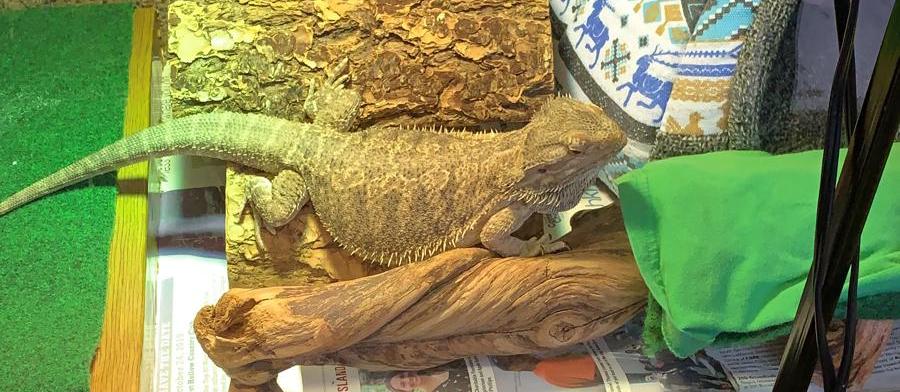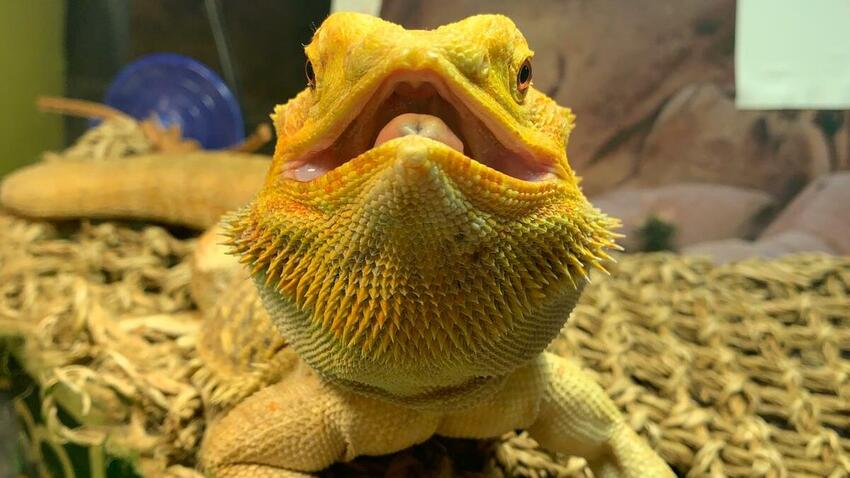Bearded dragons are considered one of the most popular pet lizards in the world. These little reptiles are a type of ancient lizard that originally came from the deserts of central Australia and currently have eight species.
Famous for their “beard-like” appearance due to the underside of their throat, they are also considered to be very social, friendly and have that happy-go-lucky attitude that makes people not afraid of having them as a pet despite their looks. They are said to bite rarely and with the proper leash, you can even take one out for walks outdoors!
Table of Contents
Habitat and Housing
The natural habitats of bearded dragons are on arid woodlands and deserts. It spends a lot of its time in bushes and trees and basking in the warmth of the sun on rocks. With this, you already have an idea of what may be the usual things your bearded dragon might do once you finish putting up their enclosures.
Just like any human, these reptiles also require a comfortable and adequate home for it to live in. May it be a terrarium, enclosure, or tank, the important thing to remember is that you are building and setting up the home of your pet so you better make it appropriate for him so that he/she would be able to grow nicely and live long.
Ace’s Recommendation
– he loves to live like a king.
We like to have lots of space and many places to hide and climb. A bigger tank is always better than a smaller one. Some of us like to climb on rocks, others like to hide. Every Beardie is different and needs a different environment. The more natural it is, the better.
[/vc_column_text][/vc_column][/vc_row]What to Consider In Setting Up?
To be able to set up the housing for your bearded dragon perfectly, we have here a list of the things you need to consider:
Tank size
A bearded dragon should have as much floor space as possible due to its size that typically grows up to 18 to 22 inches, and in some cases 24.
The minimum cage size is a 20-gallon aquarium for a young one but to accommodate it as it grows, you should get somewhere along 125-gallon of aquarium or terrarium for a full-fledged adult bearded dragon. The latter gallon will measure the cage up to 72” long, 18” wide, and 16” tall.
The cage should also be 16 inches wide so that they are able to move around if they’d like. Having a bigger aquarium, terrarium, or enclosure would prove to be a better option for a bearded dragon but if yours is still young, it might get a little insecure of it being too big so you could always add a divider or a cardboard to lessen the living space, if necessary.
Custom Terrariums
If you are able to build a quality enclosure yourself, you are free to do so! This may even be proven to cost you less than purchasing a built-one in stores. This freedom may also give you more choices and the cage you make can be customizable as how you would like it to go.
If you’ve only just gotten yourself your very first bearded dragon and the idea of making an enclosure yourself makes you reluctant to do so, then you can start with just purchasing one for the meantime.
Once you gain more experience, knowledge, and confidence in the future, and you’ve decided that you’d like to customize the home of your pet, then, by all means, go for creating it and doing it as you please so that your pet can also enjoy living in the home you have made for him/her.
Bedding
If you wish to put on beddings for your pet lizard, we recommend getting substrate bedding material so that it can be easily cleaned out and non-toxic for them if they accidentally eat it.
- Paper-based beddings are also preferable since it can be removed daily in small amounts and/or once a week completely. This goes for newspapers, butcher papers, and other recycled papers as well.
- Astroturf-like bedding or the artificial grass may also be used but should be replaced weekly because it can be easily soiled with the food and feces of your pet.

You should avoid using gravel, sand, wood shavings, walnut shells, corn cub material, as well as cat litter as beddings for your bearded dragons. Not only it is potentiality a source of intestinal impaction if accidentally eaten by your pet but it’s harder to clean.
- The most favored housing material for your enclosure or aquarium is glass because it can be easily cleaned, visually appealing, and fairly inexpensive. Acrylics, however, are lighter compared to glass but costs higher and scratches easily. We recommend using all-glass as it is better and also more convenient for you in the long run.
Accessoires
Make sure to put in large rocks that are easy enough to climb on so that it can resemble the natural habitat of the bearded dragons that they use for basking. You may also include low, horizontal, natural branches in the enclosures too, but make sure that they are safe and secure enough for them to climb on, to avoid unnecessary injuries that may take place if it falls off unexpectedly.

A clean crock that is not easily tipped to put fresh water on as well as food that is set up in shallow dish must always be available at all times.
Temperature
As a pet owner, you should know that reptiles are cold-blooded creatures. That just means that their body temperatures depend on the environment that they are in. Because bearded dragons activity level, metabolism, and digestion rate are greatly affected by the temperature of their habitat, you should be able to provide a heat source for them.
With one area of the enclosure that is warm and the other cool, your pet will be able to move around and warm or cool itself, if necessary. Keep a thermometer at both ends so that you will be able to check and guard if your bearded dragon is still getting the right temperature that it should.
In order to have a heat source, you can provide fluorescent bulbs, radiant heat bulbs, or other types of ceramic heating elements that are available in pet stores. Always remember to place these heat sources outside the cage and above one end of it.
At night, during the time your pet is sleeping, you can turn the power off of your bulb or lamp as long as the temperature within the cool end should stay at 65-80°F (18-26°C).
Lighting
Your heat source may already contain UV-emitting radiation so that the bearded dragon can bask in the heat, but if not, provide one yourself by purchasing ones that emit light in the UV-B range (290-320 nanometers) so that your pet can take in Vitamin D3.
This vitamin will help it to perform proper calcium absorption from their intestines and also make them healthier. If not given enough UV radiation, your pet may acquire a metabolic bone disease called secondary nutritional hyperparathyroidism that means that there is an imbalance in their body’s calcium and phosphorus. This is proven to be very fatal for reptiles if not treated quickly enough.
Take your pet out in a walk from time to time so that it can bask in the heat of the real sun but also look for a place that has trees nearby so that it can shade itself if it needs to. This is only recommended in a safe environment.
Safety
For the safety of your pet, a screen top is necessary for it not to go loose and going in and out of its cage whenever it may please.
By doing so, it will also prevent your bearded dragon from coming into contact and have accidental burns with the heat source of the cage, that may be as incandescent bulbs, radiant heat bulbs, or the hot basking lamp, that is needed for the warmth and UV exposure of your pet.

These are things that you should consider in setting up the perfect bearded dragon housing for your pet. Keep in mind that you are providing the entirety of the home of your pet away from its natural habitat, so you should try and give it the most natural vibe there is.
Make sure to feed and clean it always, especially its cage to avoid harmful parasites and bacteria to humans from spreading about. Always wash your hands thoroughly after handling your pet and don’t forget to check on it from time to time.
If you forget some of the things mentioned here, then come back and read again what are the things you need in order for your precious bearded dragon to stay clean and healthy. For further details you can look into our other subsections.
FAQ – Housing and habitat
What do bearded dragons need in their habitat?
You should create an enclosure that’s close to their natural habitat. That means it should consist of rocks, wood, bedding and places to hide. Furthermore there should be a warm and colder area where they can eat heat up or cool down.
The size of the tank should be big enough for your bearded dragon so she/he has enough space to run around.
Another really important item is UV-B lighting so they can get enough Vitamin D.
What size tank does a bearded dragon need?
The minimum cage size should have around 20-gallons. For bigger ones it should have 125-gallons.
The length should be at least 2x the length of your bearded dragon. The width and height should at least 1x the size of your beardie.
Do bearded dragons need a water bowl?
Yes they do. Not every bearded dragon drinks a lot but the fact that they often bump into the water bowl it helps them to stay hydrated.
Can I put live plants into the tank?
Yes you can but it’s not recommended. First of all you have to make sure that it’s not poisonous and second that they don’t eat it within a few weeks.
Which bedding is the best for bearded dragons?
There’s no perfect bedding for your bearded dragon. Especially for smaller ones it’s dangerous to put sand into the tank because they might swallow it.
The better solution are newspapers or reptile carpet liners